Founded roughly 15 years ago in Switzerland by Florian Cossy, CH Precision has gained a reputation for incredible engineering, incredible performance, incredible sonics, incredible build quality, versatile modularity, and user adjustability in the uber-high-end audiophile world. Not surprisingly, they are also widely regarded, and willingly accept the mantle, as one of the more globally expensive brands on the market. This may be evidenced by the fact that among the last few truly impressive million-dollar-(plus) audiophile systems I have experienced, CH Precision was at the center of almost all of them. Additionally, the entire product range is absolutely world-class, among the best of the best, and performs at a remarkably high level.
The CH Precision I1 Universal Integrated Amplifier falls into this same category and represents a starting point in their luxury audiophile brand. At $38,000, there is steep competition in the Integrated amp category. I know because I am reviewing a number of the best of the best. Without question, CH Precision belongs on this list of strong contenders in high-end audiophile integrated amps. How good is it? That’s what we are here to find out.
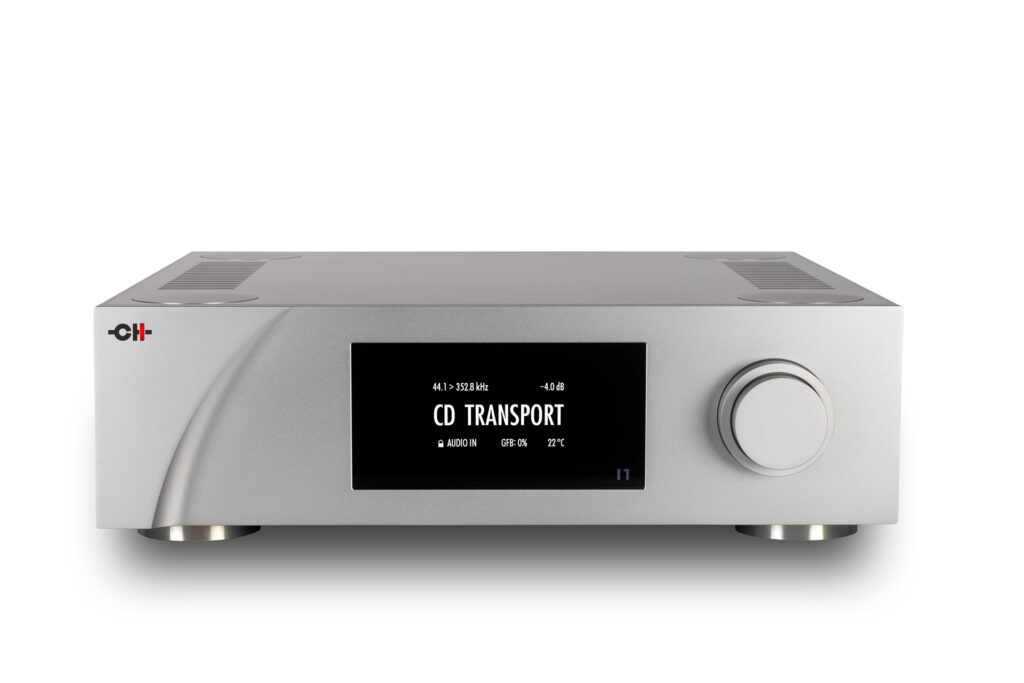
What Makes the CH Precision I1 Integrated Amp Special?
- The CH Precision I1 follows the company’s overall business model of modularity. The concept of modularity may be found throughout the CH Precision product line and is intended to allow a component to grow with the user’s evolving system needs and desired upgrades.
- While the standard integrated functions of power amplifier and stereo preamplifier sections are obviously included, modularity is fully evidenced. For instance, while the basic unit, minus any upgrades, is equipped with four digital inputs (CH-Link-HD – used to connect a CH Precision transport or other similar product, AES/EBU, S/PDIF and TosLink), two pairs of analog inputs, an integrated digital to analog converter, a hybrid volume control and two channels of power amplification, there are quite a few additional upgrades.
- These modular upgrade additions include an additional S/PDIF and AES/EBU circuit board – thus allowing a second digital device ($2,500) – an Asynchronous USB Input Board with 24-bit PCM/DSD 128 capabilities ($3,000), a Clock Master USB Streaming Board – used to receive high resolution audio directly from a music server or computer for services, such as Qobuz or Tidal ($6,000) – a Clock Synchronous Board, which may serve as the I1 system clock or connect to an external master clock ($1,500), and finally, a moving coil phonostage board ($4,500). Employing all these options raises the overall retail price for a full-loaded unit to $55,500. Each of the listed upgrades and modifications will fit in the standard enclosure, eliminating the need for any additional components and cables in the overall audio system.
- In addition a Clock Generator ($25,500) may also be utilized. And if these options not enough, the CH Precision A1.5 Stereo Amplifier ($39,500) may be added and used in supplement the output wattage (bridged or otherwise) and add a second set of speaker terminals. This level of options, upgrades, and ways to customize anything in the CH Precision line is almost unheard-of in high-performance audio.
- Digital-to-analog conversion is accomplished through multi-bit sigma-delta converters for each channel. A Ladder DAC option or multiple filter settings are not offered. Instead, CH Precision utilizes an in-house-developed digital filter they classify as a PetER (Polynomial Equations to Enhance Resolution) Spline up-sampling filter along with Wolfson delta-sigma DAC chips. As is evidenced by the entire product line, CH Precision prefers that all their engineering development be performed internally, with outside component parts used as infrequently as possible.
- The CH Precision I1 features user-controlled global amplifier feedback setting options. By taking a portion of the output power and feeding it back into the amplification stage, it tends to lower the output impedance and reduce distortion. A zero-percent setting will deliver a more open, natural, detailed and, some may, say tube-like sonic presentation. A 100-percent setting is intended to yield tighter bass control, but may also deliver a more analytical sound and more dynamic treble frequencies. There are also intermediary settings of 20 percent, 40 percent, 60 percent and 80 percent of global feedback, which offer a balance between the zero and 100-percent settings. I started with zero, then a 100-percent setting and subsequently found I was most happy with a 60-percent setting. I found this offered the best of an open, natural sound, yet also helped deliver the dynamic performance I prefer. These options offer the user an appreciable amount of control over the sonic presentation in ways most competitors’ components cannot match. This adjustable feedback will also take the place of having multiple DAC chips and filters to modify digital sound. And, of course, they also work when playing a turntable.
- Output power is rated at 100 WPC at eight ohms and 175 WPC at four ohms. A transformer rated at 100,000 microfarad (uF) reservoir of capacitance is designed to accommodate difficult speaker loads. This transformer is galvanically shielded to eliminate vibrations from entering the signal chain, thus manifesting as distortion.
- There is one set, left and right channels, of Argento speaker terminals, which will accept both spade and banana speaker cables. They will also accept bare wire, if that is a preferred choice.
- An AMOLED front screen is used for all the various user selections, which are made by one front-mounted round knob. The display is customizable by seven different colors. My favorite, surprisingly enough, was white.
- An infrared remote is included and can perform the basic tasks – volume, mute, input, polarity inversion and standby. It very conveniently has a felt-covered bottom to prevent scratches.
- An Android-only app is also installed, which means all functions of the CH Precision I1may be controlled by an Android-based phone or tablet. An iOS app is literally in development (no cost to users) and will be launched at some point in 2025.
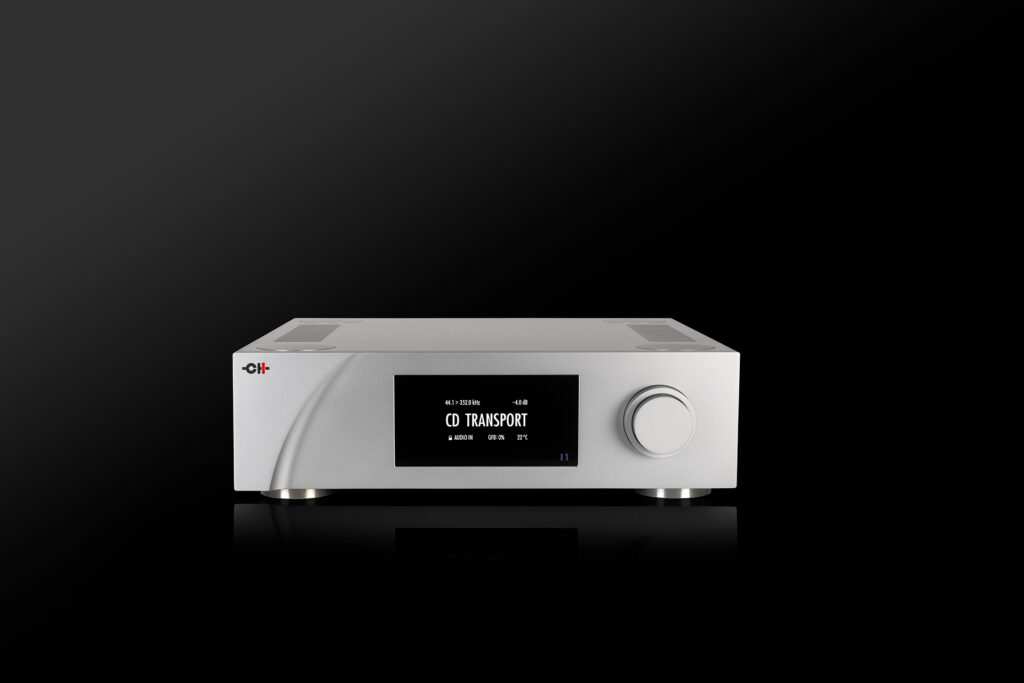
Why Should You Care About the CH Precision I1 Integrated Amplifier?
As I have abundantly learned with the last two integrated amplifiers I had the fortunate pleasure to review, these types of devices are no longer considered inferior in a world where separate components have been the de facto standard for an audiophile sound system. The level of sophistication, engineering and, most importantly, performance makes an integrated amplifier, and without question the CH Precision I1, equal in virtually almost every way to separate components – at least until the stratospherically expensive components are utilized. Factor in the outstanding reputation CH Precision has garnered, and this reputation is absolutely justified. The end result is a component that will easily function as an all-encompassing, central, unified hub for an excellent-sounding high-performance audiophile stereo system – given, of course, a concomitant level of supplementary components. Add in the modularity and the option of growing with the user’s needs over time, and the CH Precision I1 Integrated Amplifier is a device which may be enjoyed for years to come, while concurrently holding its value in the used market.
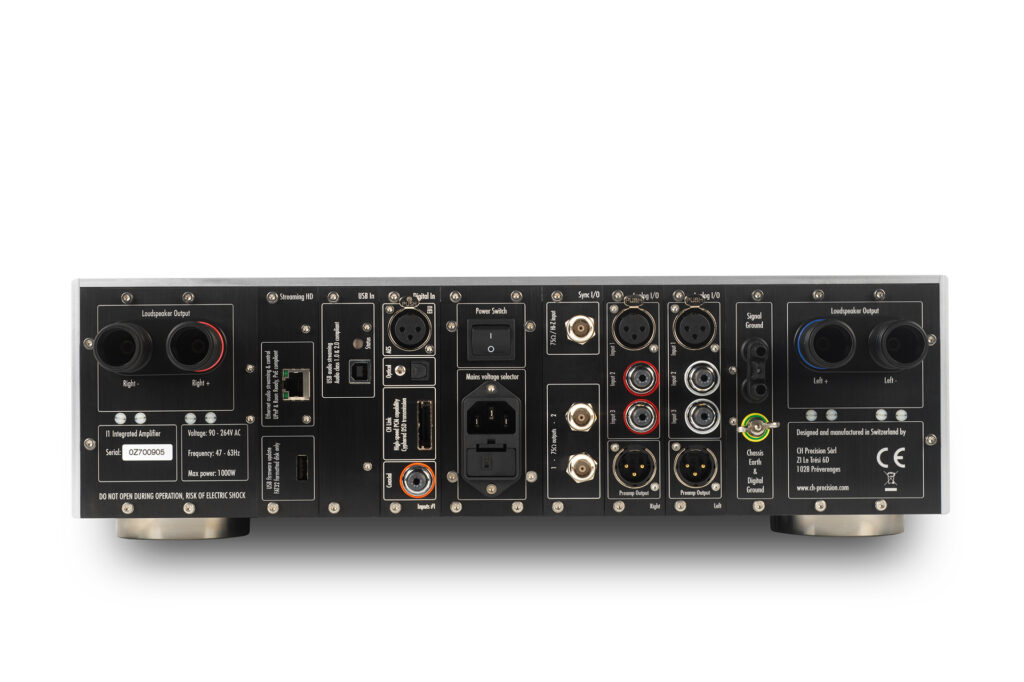
Some Things You Might Not Like About the CH Precision I1 Integrated Amplifier
- There is only one set of speaker terminals. Connecting, and individually controlling, both an A and B set of speakers is therefore not possible.
- The Argento speaker terminals only allow a fork connector (or bare wire) to attach from the bottom. This eliminates the option of routing cables in from the top or either side. For those who use a thicker or more rigid speaker cable, or have access issues to the rear of a component, this might present a problem. Conversely, banana connections may easily be made to the rear of the binding post.
- While I found no problem whatsoever with output power – in fact, I could play music at my preferred 80 dB to 85 dB level – some may question the standard output of 100 WPC at eight ohms and 175 WPC at four ohms. For those who prefer a tremendous amount of headroom, or have impossibly difficult speakers to drive, or just want to play music obscenely loud (which is not a good idea), some may feel the power output could/should be higher.
- At the time this review was written, the CH Precision app, used on a smartphone or tablet to control basically all the unit’s functions, was only available on the Android platform. To be fair, an Apple IOS app was in development at the time this review was written. So, while Apple IOS users, like myself, may find the lack of their preferred operating system unfavorable, the omission of an IOS app is temporary. The date of when a fully-functioning IOS-based software app will be released has not been published in time for inclusion in this review.
Listening With the CH Precision I1 Integrated Amplifier
Making all the connections were straightforward enough and only took a couple of minutes. As is my custom, I let Roon (learn all about Roon here) pick tracks at random and left everything alone for 24 hours before I sat down for any serious evaluations. First, I concentrated on bass response. Immediately, I noticed the bass was tight and precise. I could easily hear the individual notes on a bass guitar. Where there should have been a certain amount of resonance, there was. Otherwise, the low-frequency presentation was completely devoid of any smear or boominess, which is always a deficit. I am also not interested in peeling the paint off the walls or shattering glass with prodigious amounts of bass. In the case of the CH Precision I1, the bass, where called for by the recording, was powerful but also blended to perfection with the remainder of the frequency range. The term “overpowering bass” was not even a remote consideration. In fact, I found the overall bass response to be excellent.
Next, I wanted to judge the imaging capabilities of the CH Precision I1. Here again, I was very impressed. During my time listening, I noticed the image placement was exact and precise placed in my room. On several tracks where a large background chorus was present, it sounded like they were singing from the back of the stage. On acoustic guitars, for instance, there was a resonance just like there would be in a live setting. On other instruments, however, the immediacy, and the ability of the sonic presentation to start and stop, were captivating. At times, I somehow got the feeling I could actually hear the recording engineer moving the mixing board sliders around and adjusting the controls. While at first I thought I was certifiable and was just imagining things, I grew to highly appreciate this presentation – whether real or not, it still sounded remarkable. I only noticed one aspect of the imaging I would have preferred to be better. I thought the imaging was not spread as widely across my audio room as other devices, including my reference amp and preamp. However, this was very marginal and, because of the overall excellence of the image presentation, is only worth mentioning because of the difference in how the presentation was affected. Sonically, imaging was magnificent.
When it came to actual music, I wanted to somewhat challenge the CH Precision I1. I chose the one-hit wonder, upbeat, feel-good song “Walking on Sunshine” by Katrina and the Waves. This 1983 release is practically an anthem for happiness and optimism. It possesses a steady drumbeat, a well-recorded brass section and captivating guitars. Sadly, my version lacks the recording quality I would love for this work to have. The CH Precision I1 performed admirably with the bass and, because of the stellar imaging, I could easily and quickly identify all the various instruments. Poor recordings are quite difficult to overcome, and I thought the CH Precision I1 did an excellent job of making this otherwise sonically-challenged song sound like the joyously enthusiastic song it was always intended to be.
Another crowd pleaser, “Don’t Stop” by the Rolling Stones is a pop-oriented track that nevertheless holds with the band’s classic rock musical aesthetic. The rhythm of the track is propelled along in the mix and the CH Precision I1 kept the pace at the high-octane level the song should display. The clarity and overall recording are excellent and, let’s face it, Mick Jagger’s voice is unmistakable. The I1 portrayed his voice to perfection. Anchored by a steady drum track and well-orchestrated guitar riffs, I thought the CH Precision I1 made this song sound like the toe-tapping, finger-snapping, get-the-party-started song it was always intended to be.
Will the CH Precision I1 Integrated Amplifier Hold Its Value?
I must believe CH Precision, as a company, is one of the better brands in all of high-performance audio in terms of used resale value. Anything in the product line does not last long on the used market, and there is really not an abundance of used products available across the entire product line. In fact, many CH Precision components remain in use for long periods of time by the original owner, owing to the modularity and upgrade posture of the entire product line. Consequently, getting rid of an existing device like the CH Precision I1 is less common, compared to other brands and similar components. For this reason, holding its value is almost a certainty.
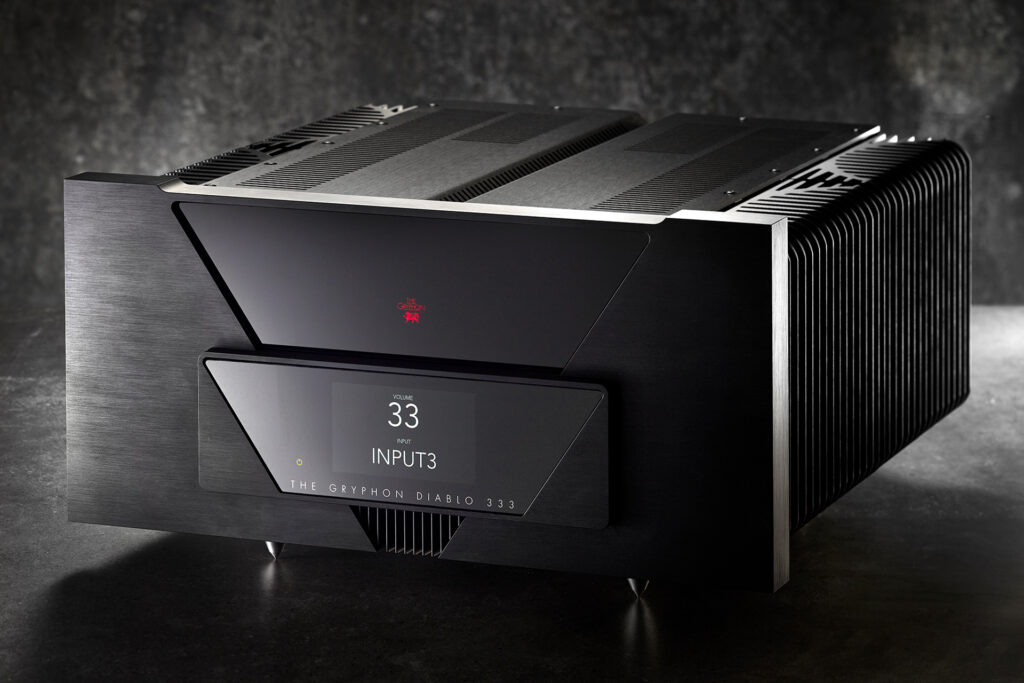
What is the Competition for the CH Precision I1 Integrated Amplifier?
Because of the two integrated amplifiers I have recently reviewed, this seems like a “stick with whatcha know” sort of thing. First to mind is the very capable Gryphon Diablo 333 Integrated Amplifier (read review here). While the base price is $24,900, a DAC module may be added for $7,600, and a phonostage module addition is $6,000. This brings the total cost to $38,500. I have yet to see firsthand an integrated amplifier that could match the Gryphon Diablo 333 in terms of raw output power. With 333 WPC at eight ohms and 666 WPC at four ohms, this amp can get very loud and possesses an astonishing amount of headroom. Most notably, the Diablo features 38 dB of gain, so the enormous power of the amplifier section may be brought very quickly to bear. I doubt this integrated amp would even notice a two-ohm speaker load. It is simply that powerful. Sonically, both the Diablo and the I1 exhibit remarkable control over the bass response and are very similar in overall presentation. However, both have their own strengths, which makes the differences more of a user decision. The CH Precision also incorporates global feedback user adjustability, which offers some level of customization. The Gryphon 333 does not offer this capability.
Next is another integrated amplifier I reviewed, the T+A PA 3100 HV (read review here), priced at $24,800. A phonostage module is available for an additional cost of $1,700, taking the total price to $26,500. A DAC module is not offered. The T+A PA 3100 HV delivers 300 WPC at eight ohms and 500 WPC (700 intermittent) at four ohms. It also has more than enough power to spare. There are six sets of RCA inputs and four sets of XLR inputs. There are two sets of rhodium-plated speaker terminals, custom-designed by T+A, which will allow the connection of both an A and B set of speakers. Sonically, the T+A PA 3100 HV tends to lean towards a more dynamic and analytical presentation. As with the CH Precision I1, T+A has no options for global feedback user modifications. In a head-to-head comparison, and based on similar global feedback settings, I would say both are more similar than different. However, I found the CH Precision to be slightly better on bass response and with a very marginal edge on dynamic presence. T+A, however, had slightly better image width. The remainder of the image presentation, as well as overall sonics, were very similar. I do like the adjustability of the CH Precision. but I also like the increased number of inputs and two sets of binding posts on the T+A.
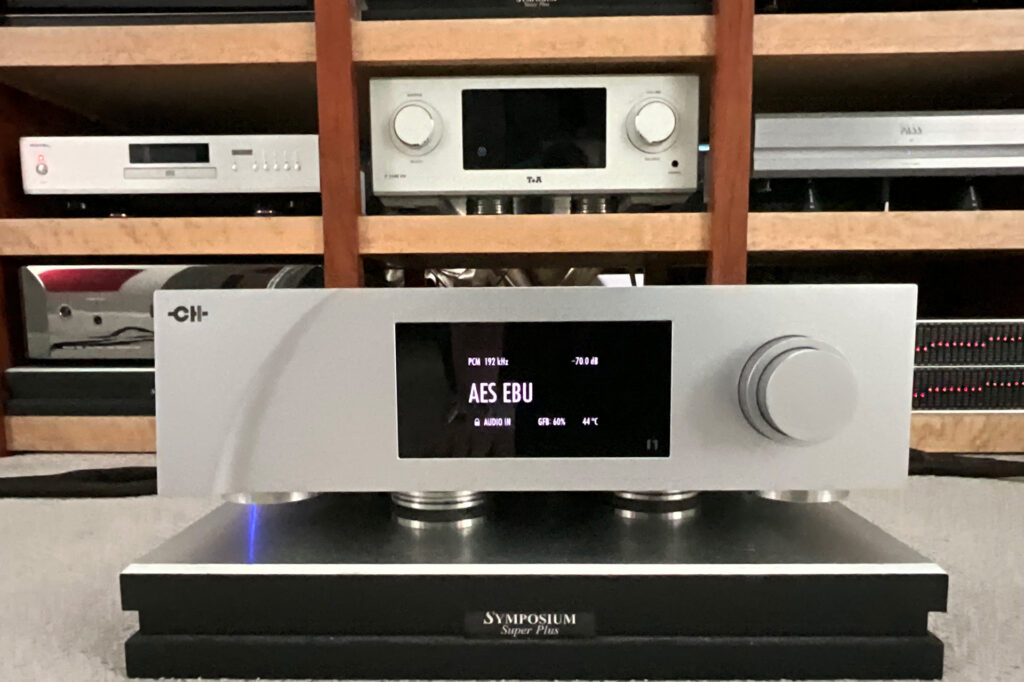
Final Thoughts on the CH Precision I1 Universal Integrated Amplifier …
Prior to starting this review, I requested, and received, a CH Precision retail price list on the I1 Universal Integrated Amplifier. When we talk about modularity, and how any one component may grow with a user’s needs and wants, I must say I was surprised to discover 11 optional upgrades and modifications available for the CH Precision I1. I am not aware of another manufacturer who takes modularity and customization to this level. Best of all, these modifications remain active for years, so buying a CH Precision component today means it may be upgraded well into the future. Most companies have one or two upgrades, and then only for certain components. CH Precision has an upgrade option for almost every item they manufacture.
I was also very impressed with the user-adjustable Global Feedback. This allows the listener to craft their own sound, at least to a point. Some listeners prefer a warmer sound, while others enjoy a more detailed, analytical and dynamic sound. Having polar opposite settings of zero and 100 percent of Global Feedback, as well as settings of 20, 40, 60 and 80 percent, allowed me to more or less find a most-preferred sonic presentation. Once again, this feature is used throughout the entire CH Precision product line.
As far as my overall impression of the sonics the CH Precision I1 rendered, here again, I was quite impressed. This integrated amp actually exceeded my expectations, and I found listening throughout the entire review process a joy. I found the excellent sonic presentation actually made me want to pay closer attention to each song to hear as many fine details as possible. The imaging was extremely accurate and provided a you-are-there simulation. The bass response was outstanding. Midrange performance was excellent and the highs, where called for, soared and were very accurately portrayed. Music was not contrived, not forced and not artificial. It easily flowed along, which very often made me lose track of the time I had spent listening to music.
I realize this is a very expensive integrated amplifier by any measure. For that matter, the entire CH Precision product line is among the more expensive audiophile brands available. But when the cost of a separate amplifier, preamplifier, DAC, phonostage and cables are considered, the cost of the basic CH Precision I1 is substantially less than the cost of separates – based on similarly-engineered components. So, the question then becomes more a matter of perception and what the user is looking for in their component choices. What I can say is my time with the CH Precision I1 was well spent. I found this device elevated the music I play most often in ways other integrated amplifiers did not. The only remining question is, could this integrated replace a group of separate components? Really good question. The answer is dependent on budget and to what level the user would like to take their audio system. One thing is for sure, however. The CH Precision I1 Integrated Amplifier is, by any measure, a world-class, best-of-the-best component when compared with its many well-qualified peers. The considerable amount of work and engineering CH Precision put into the I1 is plainly obvious and excellently executed. I found this integrated amplifier to be absolutely outstanding and one I would recommend evaluating to anyone interested in this level of component. In every respect, this integrated amplifier lives up to the reputation CH Precision has crafted for their brand because, quite simply, it’s that good.




Variable global feedback is a very cool feature.
I’m wondering how one would connect a subwoofer to the L1?
Reviewing the high end integrated amps, tough job, but……
Jealous
Hey Bryan,
There are actually three ways to connect a sub to the I1. One, and the easiest, connect the sub using an RCA or XLR cable from the sub to the Preamp Output. Two, if the sub has and supports a high level speaker input (many REL subs do for instance), you could connect the sub to the speaker output. This way, the sub and the mains see the same signal. I use this method for my stereo pair of REL subs on my amplifier. Third, and probably not very commonly done, if the I1 has the optional digital input/output circuit board, it can be configured for a digital connection method. Probably most common is the first option, connecting to the Pre Out on the I1.
As to the variable global feedback, I agree. I’m somewhat surprised more companies are not doing something similar. It does give the option of tailoring the music. And it works with analog.
Thanks for your comment!!
Paul
Hi Bryan,
The preamp outputs can be used for subwoofers while using the internal amplifiers to power the speakers.
Great review Paul! I was curious how CH Precision compared to T+A. Both are outstanding in my experience but I’ve never heard them side by side.
Many thanks Jim!!!
Another Thank you, Paul, for shining such a bright light on the CH Precision I1 Integrated Compact Stereo System. Your thoughtful words highlight exactly why this piece of engineering has captured so many hearts.
In my own vignette setup, I pair the I1 with Rockport Avior II loudspeakers, a D1.5 CD player, and an X1 Power Supply — I don’t mind the extra boxes because I truly love spinning discs, especially MQA titles, which sound phenomenal through this system.
Just a small clarification: Argento does make caps that allow for the use of banana-terminated cables. These not only make the connection easy, but also enhance performance. They can be installed on the I1 as well as other amplifiers in the CH Precision lineup — including the A1.5, M1.1, and M10.
It’s wonderful to see Future Audiophile giving high-performance gear the attention it deserves. The I1 continues to be one of our strongest-selling products. Many customers who start with it eventually expand into larger multi-box CH systems — and often repurpose the I1 into a second system or another home, thanks to its reliability and sheer musical joy.
As dealers, we’re truly blessed to have such a robust, versatile, and musically rewarding product in our stable. Paul, you rock — and you are warmly invited to visit my store anytime. I’m fortunate to have every product CH Precision makes on display for demonstration.
Warm regards,
Sunil Merchant.
Sunny Components, Inc.
Sunil, my profound thanks for your comment and the invitation to visit your dealership! Jerry has spoken so very highly of your business on more occasions than I can count. From what he has told me, your dealership is magnificent. On my next trip to the greater LA region, I will take you up on your offer to come by!
In the review, you are correct, I did mention the Argento speaker terminals. On my review sample, there were no provisions for making the attachment of a bare wire or spade connector other than from the bottom. Unfortunately, the Argento terminals would not rotate to allow a side or top mounted connection. Only from the bottom.
However, and this was noted in the review, I did point out that banana terminals could be easily used. I even plugged in some banana terminals in addition to my spade speaker terminals just to be sure both could be used at the same time. There was no issue in doing so.
If Argento has other terminals available, as I am sure they do, they were not being used on the I1 CH Precision sent me.
Once again, thank you for your kind words and for being such a great steward of our hobby.
Happy Listening!
Paul